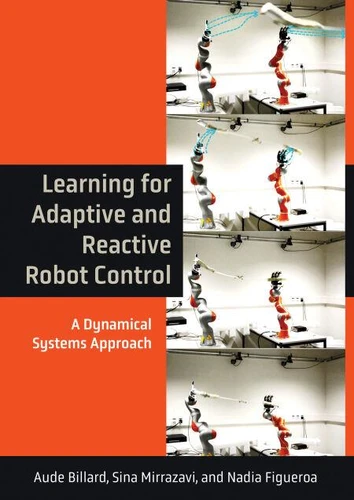Learning for Adaptive and Reactive Robot Control. A Dynamical Systems Approach
Par : , ,Formats :
Disponible dans votre compte client Decitre ou Furet du Nord dès validation de votre commande. Le format ePub protégé est :
- Compatible avec une lecture sur My Vivlio (smartphone, tablette, ordinateur)
- Compatible avec une lecture sur liseuses Vivlio
- Pour les liseuses autres que Vivlio, vous devez utiliser le logiciel Adobe Digital Edition. Non compatible avec la lecture sur les liseuses Kindle, Remarkable et Sony
- Non compatible avec un achat hors France métropolitaine
 , qui est-ce ?
, qui est-ce ?Notre partenaire de plateforme de lecture numérique où vous retrouverez l'ensemble de vos ebooks gratuitement
Pour en savoir plus sur nos ebooks, consultez notre aide en ligne ici
- Nombre de pages424
- FormatePub
- ISBN978-0-262-36701-1
- EAN9780262367011
- Date de parution08/02/2022
- Protection num.Adobe DRM
- Taille144 Mo
- Infos supplémentairesepub
- ÉditeurThe MIT Press
Résumé
Methods by which robots can learn control laws that enable real-time reactivity using dynamical systems; with applications and exercises. This book presents a wealth of machine learning techniques to make the control of robots more flexible and safe when interacting with humans. It introduces a set of control laws that enable reactivity using dynamical systems, a widely used method for solving motion-planning problems in robotics.
These control approaches can replan in milliseconds to adapt to new environmental constraints and offer safe and compliant control of forces in contact. The techniques offer theoretical advantages, including convergence to a goal, non-penetration of obstacles, and passivity. The coverage of learning begins with low-level control parameters and progresses to higher-level competencies composed of combinations of skills. Learning for Adaptive and Reactive Robot Control is designed for graduate-level courses in robotics, with chapters that proceed from fundamentals to more advanced content.
Techniques covered include learning from demonstration, optimization, and reinforcement learning, and using dynamical systems in learning control laws, trajectory planning, and methods for compliant and force control . Features for teaching in each chapter: applications, which range from arm manipulators to whole-body control of humanoid robots; pencil-and-paper and programming exercises; lecture videos, slides, and MATLAB code examples available on the author's website . an eTextbook platform website offering protected material[EPS2] for instructors including solutions.
These control approaches can replan in milliseconds to adapt to new environmental constraints and offer safe and compliant control of forces in contact. The techniques offer theoretical advantages, including convergence to a goal, non-penetration of obstacles, and passivity. The coverage of learning begins with low-level control parameters and progresses to higher-level competencies composed of combinations of skills. Learning for Adaptive and Reactive Robot Control is designed for graduate-level courses in robotics, with chapters that proceed from fundamentals to more advanced content.
Techniques covered include learning from demonstration, optimization, and reinforcement learning, and using dynamical systems in learning control laws, trajectory planning, and methods for compliant and force control . Features for teaching in each chapter: applications, which range from arm manipulators to whole-body control of humanoid robots; pencil-and-paper and programming exercises; lecture videos, slides, and MATLAB code examples available on the author's website . an eTextbook platform website offering protected material[EPS2] for instructors including solutions.
Methods by which robots can learn control laws that enable real-time reactivity using dynamical systems; with applications and exercises. This book presents a wealth of machine learning techniques to make the control of robots more flexible and safe when interacting with humans. It introduces a set of control laws that enable reactivity using dynamical systems, a widely used method for solving motion-planning problems in robotics.
These control approaches can replan in milliseconds to adapt to new environmental constraints and offer safe and compliant control of forces in contact. The techniques offer theoretical advantages, including convergence to a goal, non-penetration of obstacles, and passivity. The coverage of learning begins with low-level control parameters and progresses to higher-level competencies composed of combinations of skills. Learning for Adaptive and Reactive Robot Control is designed for graduate-level courses in robotics, with chapters that proceed from fundamentals to more advanced content.
Techniques covered include learning from demonstration, optimization, and reinforcement learning, and using dynamical systems in learning control laws, trajectory planning, and methods for compliant and force control . Features for teaching in each chapter: applications, which range from arm manipulators to whole-body control of humanoid robots; pencil-and-paper and programming exercises; lecture videos, slides, and MATLAB code examples available on the author's website . an eTextbook platform website offering protected material[EPS2] for instructors including solutions.
These control approaches can replan in milliseconds to adapt to new environmental constraints and offer safe and compliant control of forces in contact. The techniques offer theoretical advantages, including convergence to a goal, non-penetration of obstacles, and passivity. The coverage of learning begins with low-level control parameters and progresses to higher-level competencies composed of combinations of skills. Learning for Adaptive and Reactive Robot Control is designed for graduate-level courses in robotics, with chapters that proceed from fundamentals to more advanced content.
Techniques covered include learning from demonstration, optimization, and reinforcement learning, and using dynamical systems in learning control laws, trajectory planning, and methods for compliant and force control . Features for teaching in each chapter: applications, which range from arm manipulators to whole-body control of humanoid robots; pencil-and-paper and programming exercises; lecture videos, slides, and MATLAB code examples available on the author's website . an eTextbook platform website offering protected material[EPS2] for instructors including solutions.



